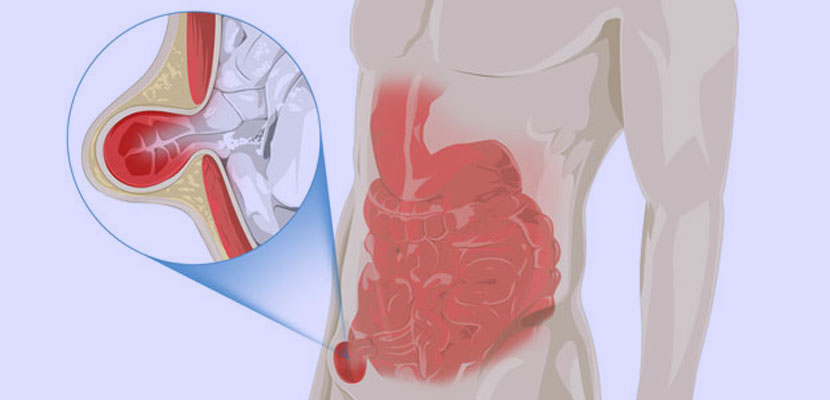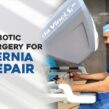You would have heard of a hernia several times in your life, wondering what it is and how to treat it?
A hernia occurs when a part of your gut or fatty tissue bulges through a gap or weak spot in your belly (abdomen) wall. It would manifest as a painless swelling but can occasionally cause discomfort and sharp pain when you cough, stand, strain, or bend over. Medical conditions such as poor diet, pregnancy, obesity, enlarged prostate, and peritoneal dialysis may also lead to herniation.
Most hernias that develop in the cavity between the chest and belly are abdominal hernias, which are harmless. However, they do not resolve spontaneously and may require surgical correction of the defective muscles to avoid serious complications. Larger hernias are more arduous to treat than smaller ones. So, if you have any symptoms of a hernia, talk to your doctor immediately so he/she can decide which treatment plan is best suited to your condition.
Table Of Contents
- Types of Hernia
- When is it okay to delay Hernia Treatment?
- When do you need Hernia Treatment?
- What are your Treatment Options?
- Why should you opt for Laparoscopic Surgery?
- Reach us
Types of Hernia
The most common forms of abdominal hernia include:
- Inguinal or groin hernia: Most common type affects more men (70%) than women. It occurs when a portion of your bowel or fatty tissue, as well as part of the belly cavity lining (peritoneum), bulges through the inguinal canal (passage by which testes leave the belly cavity and enters the scrotum during fetal development) into the groin area. Common symptoms include pressure or burning sensation, swelling, and pain around the testicles or groin area that intensifies with coughing or lifting heavy objects.
- Femoral hernia: It is common in women who are obese or have multiple pregnancies. It occurs when the tissue or part of the bowel enters the femoral canal into the inner thigh or groin.
- Umbilical hernia: When a part of your bowel pushes through the belly muscle near the navel, it leads to an umbilical hernia. Common in children and women with obesity and pregnancy.
- Incisional hernia: It is common in people who have had prior surgeries related to the belly. It arises when the organ or tissue protrudes through the partially healed wound from a previous incision or scar.
- Hiatal hernia: Unlike other hernias, it is characterized by acid reflux resulting in heartburn or chest pain. It happens when a person’s stomach bulges through the hiatus, an opening in the diaphragm (a thin muscle that separates the chest from the belly) from where your food pipe passes.
Other less common types of hernia include:
- Diaphragmatic hernia: It is a congenital anomaly where the belly organs pass the opening in the diaphragm and move upward into a baby’s chest.
- Epigastric hernia: It happens when fat tissue between the rib cage and the navel protrudes from the belly.
- Spigelian hernia: It occurs when the fat tissue pokes through the sides of your belly muscles below your navel. Common among men over 50 years.
When is it okay to delay Hernia Treatment?
A small hernia with no symptoms does not demand surgery; however, your doctor can take “watchful waiting” approach to reduce the risk of complications. In such situations, external compression belts such as trusses, binders, or corsets may be advised to push the protruding tissue back into your belly and keep it there.
When do you need Hernia Treatment?
Your doctor may decide to operate on you if you have the following conditions:
- The hernia causes pain and discomfort or when it is growing bigger.
- The portion of your bowel gets trapped in the abdominal wall and cannot be pushed back (incarcerated) to cause nausea, vomiting, and a painful lump in the groin.
- When the hernia becomes strangulated (bulged tissue loses the blood supply), a medical emergency requiring immediate surgical intervention, or else it causes infection or death.
What are your Treatment Options?
Several surgical hernia repair options are available. But, according to a person’s clinical condition and the type and location of the hernia, the 2 main approaches are:
- Open surgery: It’s a standard procedure for repairing a hernia where the surgeon will push the
displaced organ or fat tissue back in the abdomen and fix the weakened area of the muscle using dissolvable stitches and a mesh patch (hernioplasty). A mesh is a synthetic flexible material useful in providing extra support while keeping the hernia from recurrence.For most people, recovery time after open hernia repair is about 4–5 weeks, during which heavy physical exercise or strenuous activity is unadvisable.
- Laparoscopic or keyhole surgery: It’s a minimally invasive approach to hernia repair. During surgery, you will be under general anesthesia. When the anesthesia takes effect, your surgeon will make 3 or 4 small cuts (about 1 cm long) under your navel or at the navel itself. Then, your belly is inflated with a harmless gas (carbon dioxide) to provide a better view of belly organs or the muscle wall. Later, the surgeon will place a thin tube into one of these cuts, through which a laparoscope is inserted. A laparoscope is a lighted tube with a tiny video camera attached that guides the surgeon through the hernia repair process. Through other incisions, your surgeon will
insert special surgical tools to push the hernia back in place. A mesh will then be placed to reinforce the gap on the abdominal muscle wall. Finally, the overlying skin and the tissue at the incision point will be closed with stitches or tape, barely visible after a few months.
Two types of laparoscopic hernia repair surgery useful in treating inguinal hernia are:
- Transabdominal preperitoneal (TAPP): Hernia is repaired through the abdominal cavity.
- Totally Extraperitoneal: Latest laparoscopic technique. The hernia is accessed without entering the abdominal cavity.
Why should you opt for Laparoscopic Surgery?
Some common reasons include:
- A perfectly safe surgical procedure
- Less invasive
- Reduce pain and discomfort after surgery requires fewer pain medications.
- Recovery time is shorter, about 2 weeks.
- Quicker return to work and normal activities.
- Fairly a few post-operative complications.
- Excellent cosmetic results due to smaller incisions.
- The cost of surgery and hospitalization is less than the traditional approach.
Hernias are a common issue that can occur to anyone at any time. While there are many different hernias and several surgical options to fix them, laparoscopic hernia repair surgery is the most preferred option. Talk to your doctor today to learn more about the procedure and make an informed decision about this surgery.
Reach us
If you are looking for an effective treatment for hernia, then get in touch with us via email or phone call. Our specialist, Dr. Parthasarathy is one of the most renowned surgical gastroenterologists in Hyderabad, India. He has about 15 years of experience and has performed 3000+ advanced laparoscopic procedures, also he performs more than a hundred successful surgeries for hernia every year.



